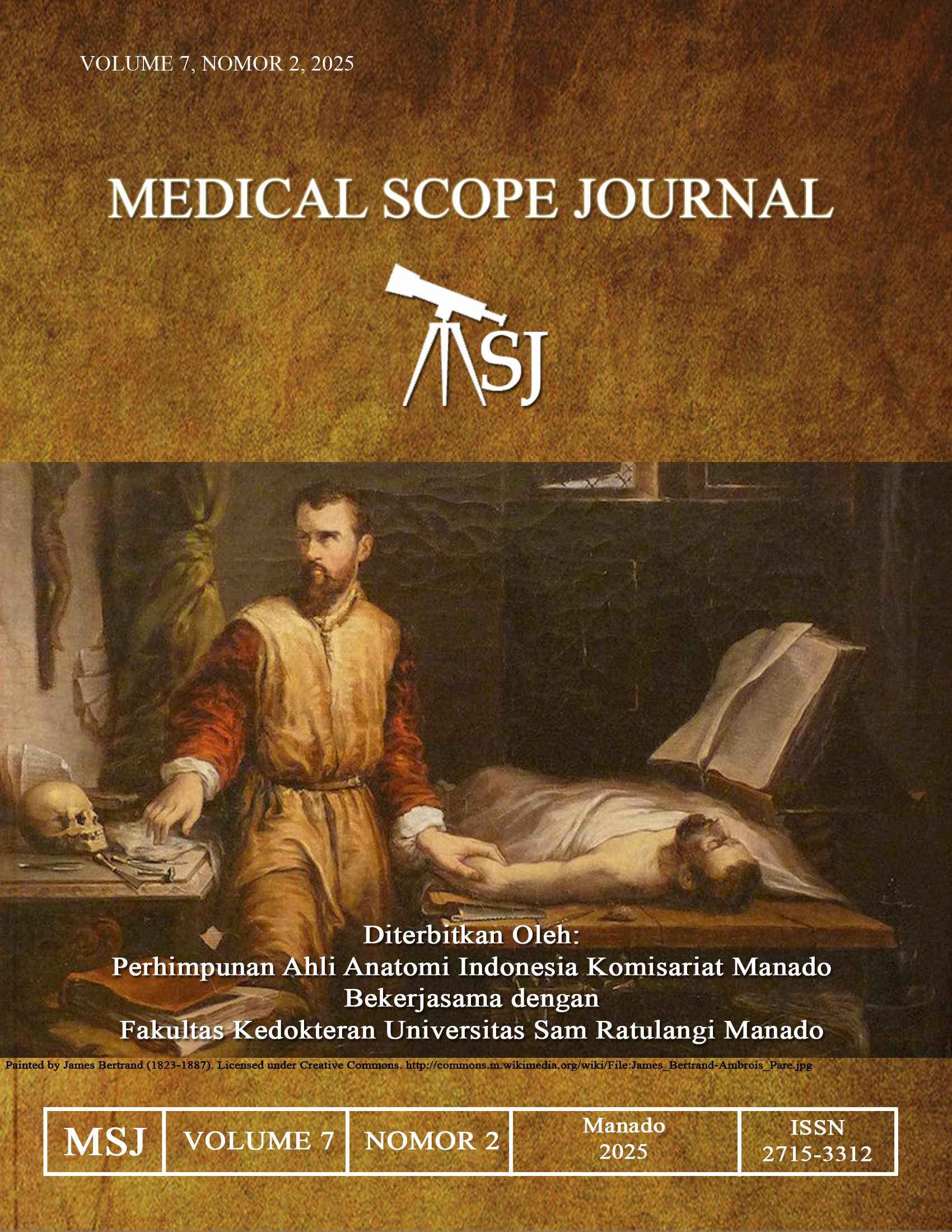Pengaruh Rehabilitasi Kardiovaskular terhadap Kapasitas Fisik pada Pasien Gagal Jantung
DOI:
https://doi.org/10.35790/msj.v7i2.60821Abstract
Abstract: Cardiovascular rehabilitation is one of the essential management strategies recommended to enhance functional capacity of patients with heart failure. This study aimed to determine the effect of cardiovascular rehabilitation on physical capacity in heart failure patients at Prof. Dr. R. D. Kandou Hospital Manado. This was a descriptive and analytical method with a retrospective and cross-sectional design. This study involved 145 heart failure patients undergoing cardiovascular rehabilitation, of whom 48 fulfilled the inclusion criteria, while 97 were excluded. The results showed that majority of participants were male, aged 45–59 years, and had a body mass index (BMI) in the obesity I category. Most patients had hypertension, dyslipidaemia, and were prescribed ACE-I/ARB and statin therapies. Most participants' ejection fractions were classified as reduced (<40%) or mildly reduced (40–49%). Statistical analysis using the paired t-test showed significant improvements in 6-minute walk test distance, VO2 Max, and METs after cardiovascular rehabilitation (p-value <0.05 for each variable). In conclusion, cardiovascular rehabilitation significantly improved physical capacity in heart failure patients, as evidenced by increased 6-minute walk test distance, VO2 Max, and METs. These findings indicate a positive effect of cardiovascular rehabilitation on the physical capacity of heart failure patients at Prof. Dr. R. D. Kandou Hospital Manado.
Keywords: cardiovascular rehabilitation; physical capacity; heart failure
Abstrak:Rehabilitasi kardiovaskular merupakan salah satu strategi penatalaksanaan penting yang direkomendasikan untuk meningkatkan kapasitas fungsional pasien gagal jantung. Penelitian ini bertujuan untuk menganalisis pengaruh rehabilitasi kardiovaskular terhadap kapasitas fisik pada pasien gagal jantung di RSUP Prof. Dr. R. D. Kandou Manado. Jenis penelitian ialah deskriptif analitik dengan desain potong lintang retrospektif. Sampel penelitian ialah 145 pasien gagal jantung yang menjalani rehabilitasi kardiovaskular; 48 pasien memenuhi kriteria inklusi dan 97 pasien dieksklusi. Hasil penelitian mendapatkan mayoritas pasien ialah laki-laki, berusia 45–59 tahun, dengan indeks massa tubuh (IMT) kategori obesitas I. Sebagian besar pasien memiliki hipertensi, dislipidemia, dan mendapatkan terapi ACE-I/ARB serta statin. Sebagian besar fraksi ejeksi pasien dikategorikan sebagai reduced ejection fraction (<40%) atau mildly reduced ejection fraction (40–49%). Analisis statistik menggunakan uji paired t-test menunjukkan peningkatan bermakna pada jarak tempuh uji jalan 6 menit, VO2 Max, dan METs setelah rehabilitasi kardiovaskular (nilai p<0,05 untuk setiap variabel). Simpulan penelitian ini ialah rehabilitasi kardiovaskular secara bermakna meningkatkan kapasitas fisik pasien gagal jantung, yang ditunjukkan oleh peningkatan jarak tempuh uji jalan 6 menit, VO2 Max, dan METs. Temuan ini mengindikasikan adanya pengaruh positif rehabilitasi kardiovaskular terhadap kapasitas fisik pasien gagal jantung di RSUP Prof. Dr. R. D. Kandou Manado.
Kata kunci: rehabilitasi kardiovaskular; kapasitas fisik; gagal jantung
References
World Health Organization. Cardiovascular diseases (CVDs). [cited 2024 Sep 14]. Available from: https://www.who.int/news-room/fact-sheets/detail/cardiovascular-diseases-(cvds)
GBD Results. Institute for Health Metrics and Evaluation. [cited 2024 Sep 14]. Available from: https://vizhub.healthdata.org/gbd-results
Kemenkes RI. Penyakit Jantung. In: Survei Kesehatan Indonesia (SKI) 2023 Dalam Angka. Jakarta: Kementerian Kesehatan Republik Indonesia; 2023. p. 255. Available from: https://www. badankebijakan.kemkes.go.id/ski-2023-dalam-angka/
Edgardo OL, Ballard BD, Jan A. Cardiovascular Disease. In: StatPearls [Internet]. Treasure Island (FL): StatPearls Publishing; 2024 [cited 2024 Sep 14]. Available from: http://www.ncbi.nlm.nih.gov/books/NBK535419/
Shahjehan RD, Bhutta BS. Coronary Artery Disease. In: StatPearls [Internet]. Treasure Island (FL): StatPearls Publishing; 2024 [cited 2024 Sep 14]. Available from: http://www.ncbi.nlm.nih.gov/books/ NBK564304/
Institute for Quality and Efficiency in Health Care. Coronary artery disease: Learn More – Complications of coronary artery disease. In: InformedHealth.org. Institute for Quality and Efficiency in Health Care (IQWiG); 2023 [cited 2024 Sep 14]. Available from: https://www.ncbi.nlm.nih.gov/books/NBK355309/
Rampengan SH. Gagal Jantung. In: Buku Praktis Kardiologi. Jakarta: Badan Penerbit FKUI; 2014. p. 104–15. Available from: https://repo.unsrat.ac.id/1130/
Schwinger RHG. Pathophysiology of heart failure. Cardiovasc Diagn Ther. 2021;11(1):263–76. Doi: https://doi.org/10.21037/cdt-20-302
McDonagh TA, Metra M, Adamo M, Gardner RS, Baumbach A, Böhm M, et al. 2023 Focused Update of the 2021 ESC Guidelines for the diagnosis and treatment of acute and chronic heart failure. Eur Heart J. 2023;44(37):3627–39. Doi: https://doi.org/10.1093/eurheartj/ehad195
Nugraha BA, Fatimah S, Kurniawan T. Fatigue pada pasien gagal jantung. Journal Medika Cendikia. 2016;3(1):58–67. Available from: https://jurnalskhg.ac.id/index.php/medika/article/view/49
Tsutsui H, Isobe M, Ito H, Ito H, Okumura K, Ono M, et al. JCS 2017/JHFS 2017 Guideline on Diagnosis and Treatment of Acute and Chronic Heart Failure ― Digest Version ―. Circ J. 2019;83(10):2084–184. Doi: https://doi.org/10.1253/circj.cj-19-0342
Bäck M, Brigitte Hansen T. ESC Prevention of CVD Programme: Rehabilitation [Internet]. [cited 2024 Sep 14]. Available from: https://www.escardio.org/Education/ESC-Prevention-of-CVD-Programme/Rehabilitation
Rahmad N, Ellina AD, Nurdina N, Wardani R. Pengaruh Latihan aktifitas rehabilitasi jantung fase II terhadap tingkat kebugaran dan daya tahan pasien penyakit jantung koroner. Jurnal Penelitian Kesehatan Suara Forikes. 2022;13(4):1057–62. Available from: https://forikes-ejournal.com/index.php/SF/article/view/sf13431
Muttaqien F, Yulvina Y, Sari RN, Syarif F, Wahyudati S, Sofia SN, et al. Pengaruh latihan sirkuit terhadap biomarker inflamasi,kapasitas fungsional, fungsi paru, dan kualitas hidup pasien gagal jantung kronik. Medica Hospitalia. 2019;6(1):48–53. Doi: https://doi.org/10.36408/mhjcm.v6i1.379
Lumi AP, Joseph VFF, Polii NCI. Rehabilitasi jantung pada pasien gagal jantung kronik. Jurnal Biomedik. 2021;13(3):309. Doi: https://doi.org/10.35790/jbm.v13i3.33448
Cannière HD, Smeets CJP, Schoutteten M, Varon C, Tellez JFM, Hoof CV, et al. Short-term exercise progression of cardiovascular patients throughout cardiac rehabilitation: an observational study. JCM. 2020;9(10):3160. Doi: https://doi.org/10.3390/jcm9103160
Ciani O, Piepoli M, Smart N, Uddin J, Walker S, Warren FC, et al. Validation of exercise capacity as a surrogate endpoint in exercise-based rehabilitation for heart failure. JACC: Heart Failure. 2018;6(7):596–604. Doi: https://doi.org/10.1016/j.jchf.2018.03.017
Tiksnadi BB, Ambari AM, Adriana M. Uji jalan 6 menit (UJ6M) pada pasien pasca sindrom koroner akut. IJC. 2019;40(1). Available from: http://ijconline.id/index.php/ijc/article/view/913
Giannitsi S, Bougiakli M, Bechlioulis A, Kotsia A, Michalis LK, Naka KK. 6-minute walking test: a useful tool in the management of heart failure patients. Ther Adv Cardiovasc Dis. 2019;13: 1753944719870084. Available from: https://pubmed.ncbi.nlm.nih.gov/31441375/
Rengo JL, Savage PD, Barrett T, Ades PA. Cardiac rehabilitation participation rates and outcomes for patients with heart failure. J Cardiopulm Rehabil Prev. 2018;38(1):38–42. Doi: https://doi.org/10.1097 /hcr.0000000000000252
Chen YW, Wang CY, Lai YH, Liao YC, Wen YK, Chang ST, et al. Home-based cardiac rehabilitation improves quality of life, aerobic capacity, and readmission rates in patients with chronic heart failure. Medicine. 2018;97(4):9629. Doi: https://doi.org/10.1097/md.0000000000009629
Radi B, Tiksnadi BB, Dwiputra B, Sarvasti D, Ambari AM. Panduan Rehabilitasi Kardiovaskular. Jakarta: PERKI; 2019. Available from: https://inaheart.org/guidelines/panduan-rehabilitasi-kardiovaskular
Candra AT, Setiabudi MA. Analisis tingkat volume oksigen maksimal (VO₂Max) Camaba Prodi PJKR. Jurnal Pendidikan Kesehatan Rekreasi. 2022 ;7(1):10-7. Doi: 10.5281/zenodo.4420388
Strasser B, Burtsher M. Survival of the fittest VO sub 2 sub max a key predictor of longevity. Front Biosci. 2018;23(8):1505–16. Available from: https://doi.org/10.2741/4657
Warner A, Vanicek N, Benson A, Myers T, Abt G. Agreement and relationship between measures of absolute and relative intensity during walking: A systematic review with meta-regression. Murias JM, editor. PLoS ONE. 2022;17(11):0277031. Available from: https://doi.org/10.1371/journal.pone.0277031
Myers J, Vainshelboim B, Kamil-Rosenberg S, Chan K, Kokkinos P. Physical activity, cardiorespiratory fitness, and population-attributable risk. Mayo Clinic Proceedings. 2021;96(2):342–9. Available from: https://doi.org/10.1016/j.mayocp.2020.04.049
Raghuveer G, Hartz J, Lubans DR, Takken T, Wiltz JL, Mietus-Snyder M, et al. Cardiorespiratory fitness in youth: an important marker of health: a scientific statement from the American Heart Association. Circulation. 2020;142(7):e101-e118. Doi: https://doi.org/10.1161/CIR.0000000000000866
Downloads
Published
How to Cite
Issue
Section
License
Copyright (c) 2025 Richard L. Santoso, Victor F. F. Joseph, Agnes L. Panda

This work is licensed under a Creative Commons Attribution-NonCommercial 4.0 International License.
COPYRIGHT
Authors who publish with this journal agree to the following terms:
Authors hold their copyright and grant this journal the privilege of first publication, with the work simultaneously licensed under a Creative Commons Attribution License that permits others to impart the work with an acknowledgment of the work's origin and initial publication by this journal.
Authors can enter into separate or additional contractual arrangements for the non-exclusive distribution of the journal's published version of the work (for example, post it to an institutional repository or publish it in a book), with an acknowledgment of its underlying publication in this journal.
Authors are permitted and encouraged to post their work online (for example, in institutional repositories or on their website) as it can lead to productive exchanges, as well as earlier and greater citation of the published work (See The Effect of Open Access).










